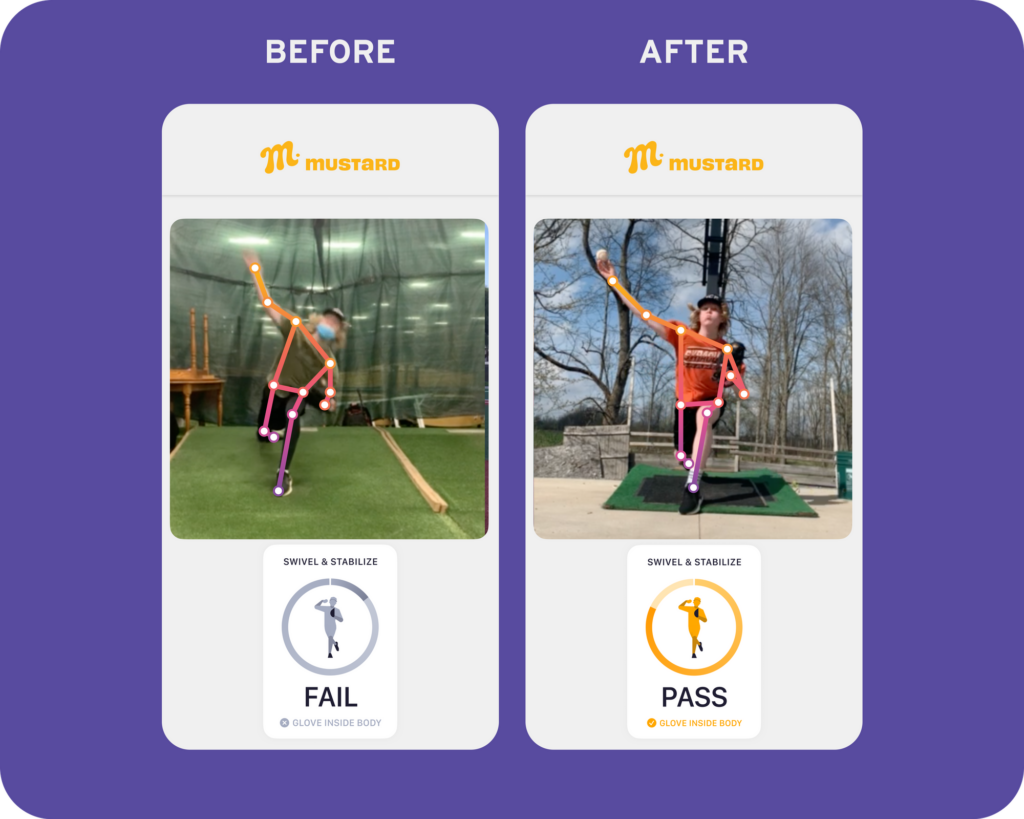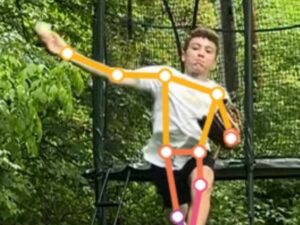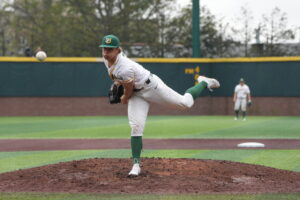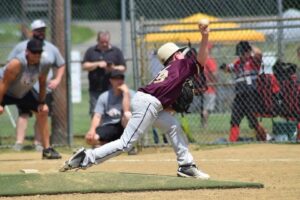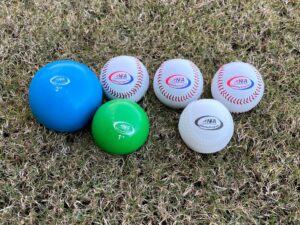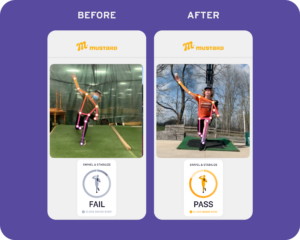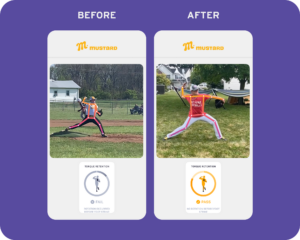By Tom House, PhD, with Lindsay Berra
As a pitcher’s shoulders begin to square up toward home plate, the glove needs to swivel so the palm is facing the chest and stabilize over the landing foot, inside the width of the torso, between the shoulders and the belly button. The torso should move toward the glove, not vice-versa, because if you pull the glove to the hip, the glove will be moving – relative to the lower body – during the part of the delivery when it should be stable. An unstable or soft glove causes mechanical inefficiencies that interfere with energy translation and can cause pitchers to miss high and low with their pitches, while a stable glove adds distance to a pitcher’s release point and keeps energy moving in the proper direction, down Broadway to home plate. In the Mustard app, this variable is called “swivel and stabilize.”
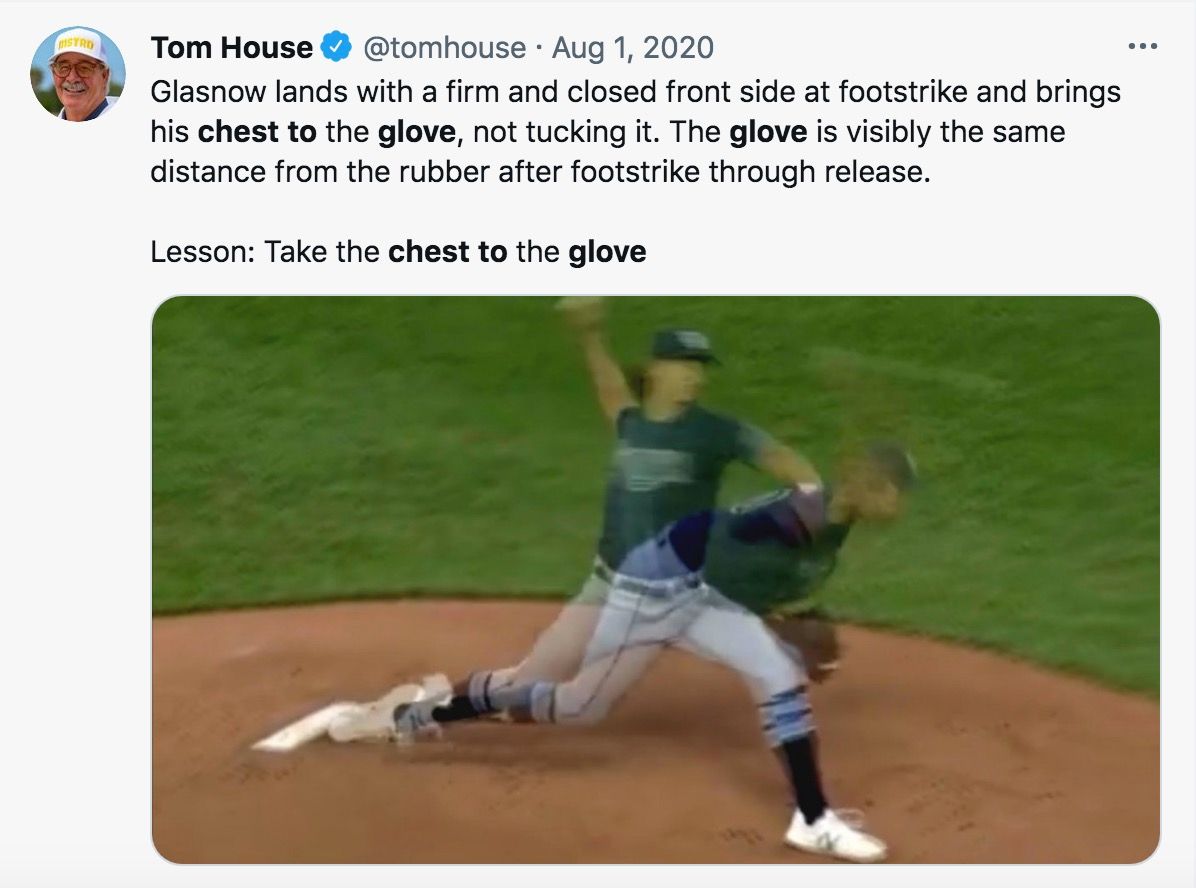
Opposite and Equal Must Happen First
An opposite and equal position with the arms must be achieved first, or swivel and stabilize will be difficult to accomplish. What does opposite and equal mean? Simply put, the glove arm and throwing arm should be mirror images of each other after the hands break. When the arms are spread equally, the flex in the forearm and elbow should be exactly the same. All variations of opposite and equal positions are OK. They don’t have to be straight angles, but if one elbow is bent, the other should be bent about the same amount. However, when squaring to throw, if you land with your arms in an upside down W and the glove is down, you will have to swivel and stabilize it upwards, and if you land with your arms in goalpost position and the glove is up, you’ll have to swivel and stabilize it downwards.
Opposite and equal arm angles at foot strike will usually put the glove in the general proximity over the front foot. At that point, the pitcher can then squeeze the glove to stabilize it as he or she swivels it from palm down to facing toward his torso. The swivel action happens just after trunk rotation begins, as the shoulders and chest are coming square to home plate.
Opposite and Equal Can Be Hard for Kids
A baseball weighs five ounces, while an average baseball glove weighs 26 ounces. So, one of the biggest issues we see is that the glove is too big or too heavy for a pre-adolescent, and he or she isn’t strong enough to keep the glove up or swivel and stabilize it into proper position. A lot of young pitchers will drop the glove down toward the ground and then back to the hip because they lack the functional strength to hold up that extra pound of weight. This obviously gets easier as pitchers mature and grow stronger, but you can address it in two ways. First, have young pitchers use the lightest glove possible; they don’t need a laundry basket-sized glove on the mound! Second, try putting a baseball in their glove in practice when playing catch and doing bullpens. Having the extra ball in the glove increases their proprioceptive awareness of where the glove is in space and also overloads to build strength.
Equal 👏 And 👏 Opposite https://t.co/edQoeoytSm
— Tom House (@tomhouse) May 24, 2020
Good Balance Can Take Care of Swivel and Stabilize
The body is bilateral, and you want to have complete balance between the left and right sides as you go down the mound. Think about walking a tightrope on the center line from the middle of the rubber to the middle of home plate, and mirror imaging of the left and right sides helps you maintain that balance and posture as you go down the mound. You want to maintain perfect balance as the hips deliver the shoulders and the shoulders deliver the ball. All of that energy that was going forward into foot strike has to stop to transfer foot pounds of energy up the chain and into the ball. If weight transfer and energy translation are executed properly, swivel and stabilize happens naturally. The glove will be firm and in a good position.
Glove Position is Also Important for Safety
In swivel and stabilize, 99% of the time, the back of the glove is toward home plate. Maybe 1% of pitchers have the glove open toward home plate. I immediately think of Al Downing, the Los Angeles Dodgers pitcher who gave up Hank Aaron’s 715th home run, which I caught in the Atlanta Braves bullpen. But as long as the glove is in front of the body, the pitcher is in good shape. One of the reasons we push swivel and stabilize is so kids can defend themselves. With the trampoline effect of baseballs coming off of aluminum bats, so many young pitchers are getting hit in the face or the side of the head, and so often, it’s because kids finish their deliveries with their gloves behind their butts and can’t defend themselves. Proper glove position will happen naturally if the kinetic sequence is good. But, if not, it’s a teach to help you get more energy more efficiently to the baseball, and to ensure your glove is in the proper place to make plays. One cue I use with kids is “take a bit out of the burger.” If you tell them to imagine taking a bite out of a cheeseburger in the top of their glove at release point, it’s something they can visualize, and that visualization often helps swivel and stabilize take care of itself.
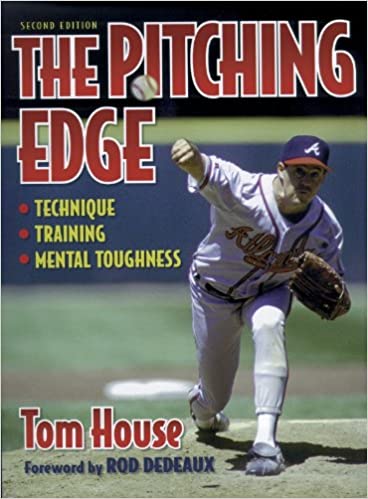
Swivel and Stabilize Can Help with Shoulder Over-Rotation
Like back foot drag line can help with head position, swivel and stabilize can help keep the shoulders from over-rotating. As the shoulders square up toward home plate, the lower back is in hyperextension and goes into flexion and delivers energy up the chain to the shoulders and then the arm. When all the momentum and energy is directed toward home plate, swiveling and stabilizing the glove allows you to work against that glove to keep all your energy going straight into the baseball. Kids who over-rotate their shoulders, who can’t keep the glove in front, will lose energy with over-rotation of the arm and the glove spinning out.
Your Misses Can Tell You A lot
If you chronically miss the strike zone high and low, it is most often a glove issue, which is an issue with swivel and stabilize. If you miss right and left, it’s usually a balance and posture issue with your head position, but the glove can also affect posture, so there are a few ways to skin the cat. If you have good balance and posture, the glove generally fixes itself, so it’s helpful to go back to that part of the delivery and address issues upstream so there is nothing to fix downstream. The biggest problem most coaches have is they recognize that a kid has a swivel and stabilize issue and they try to fix it out of sequence when it could be fixed by GFF – going forward fast – or fixing balance and posture. There are biomechanical imperatives and biomechanical inevitabilities; if you take care of your imperatives in the right sequence, the glove will fix itself. It only has to be a teach if it has to be a teach.
If you’d like more great content from Mustard, and you’d like to evaluate and improve your own pitching mechanics, download the Mustard pitching app today.

